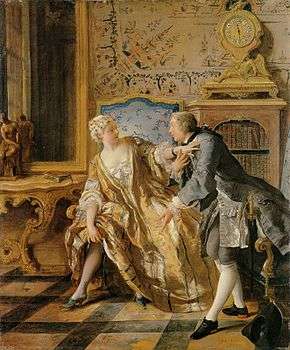Jean François de Troy

Jean François de Troy (27 January 1679, Paris – 26 January 1752, Rome) was a French Rococo painter (including of frescoes) and tapestry designer. In his lifetime he was regarded as one of France’s finest history painters. He was also in demand for his decorative paintings, genre paintings and portraits. He is regarded as the inventor of the tableaux de modes ('paintings of fashions'), which attempted to provide an authentic portrayal of contemporary manners, fashions and pastimes.
He was the Director of the French Academy in Rome from 1738.[1]
Life

He was a scion of a family of painters. His father was the portrait painter François de Troy (1645–1730). His father was his first teacher. After he failed to win the Prix de Rome, he went at his father's expense to Italy from 1699 to 1706. He stayed initially in Rome, where he was given a room at the French Academy. He also visited northern Italian cities. He was at the same time aggregated and admitted to the Académie française in July 1708, presumably on the strength of his composition Niobe and her Children (Musée Fabre) but certainly not without a little help of his father who was then the director of the Académie française.[2][3]
He undertook commissions for the Palace of Versailles and the Palace of Fontainebleau between 1724 and 1737. In 1738 he was appointed Director of the French Academy in Rome and spent the rest of his life there. He was also elected as an honorary member of the Roman Academy of St Luke, and subsequently appointed briefly its director in 1744.[4]
De Troy was twice ennobled in his lifetime, the first time when he bought the office of the secrétaire du roi ('secretary to the King') and a second time on the award of the ordre de Saint Michel. According to contemporary reports he lived a luxurious life style in Rome and entertained guests from the higher social circles in Rome.[3]
De Troy's wife died prematurely, and he lost all of his seven children. Jean François de Troy died on 26 January 1752 in Rome.
Work
General
The successful career of de Troy was based initially on large historical and allegorical compositions, such as Time Unveiling Truth (1733, National Gallery, London). A versatile artist, he was a prominent painter of histories and mythologies in a colourful and fluent manner which owed something to both Veronese and Peter Paul Rubens.

During his residence in Rome, de Troy was also active as a fresco painter. He made a fresco in the north aisle of the ancient basilica Santi Bonifacio ed Alessio depicting Saint Gerolamo Emiliani introducing orphans to the Virgin.
Tableaux de mode
He is now more highly regarded for his smaller (cabinet-sized) spirited scenes of elegant social life, painted in Paris between 1725 and 1738.[3] These pictures depict fashionable people from his time in parks or interior settings who are engaged in courting, card playing, or reading to each other. While based on the fêtes galantes of Watteau and Nicolas Lancret and on 17th-century Dutch genre painting, de Troy's composition distinguish themselves through the detail of clothing and furnishings. These tableaux de modeare also characterized by the meticulous handling of the paint and their luxurious and modish qualities.[3]
These compositions are believed to be based on de Troy's personal experiences as he was an active member of the fashionable world he depicted.[2] The closeness to Watteau is evidenced by the fact that The Alarm, or the Gouvernante Fidèle (1723, Victoria and Albert Museum, London) was attributed to Watteau in the 19th century.
Tapestry designs
He designed two sets of tapestries for the Gobelins, each consisting of seven tapestries, one on the Story of Esther (1737–40) and the other on the Story of Jason (1743–46). The cartoons for the tapestries were exhibited to great acclaim. In his tapestry designs de Troy abandoned narrative clarity in favour of a profusion of picturesque and anecdotal detail and brilliant colour effects.[1]
Main paintings
- Before the Ball (1735, Getty Center)
- A Hunting Meal (1737, Musée du Louvre, Paris)
- Luncheon with Oysters (1735) This was the first painting depicting sparkling champagne.[5]
- The Declaration of Love (1735)
References
- 1 2 Laurie G. Winters. "Troy, de." Grove Art Online. Oxford Art Online. Oxford University Press. Web. 6 May. 2016
- 1 2 Everett Fahy, Jayne Wrightsman, The Wrightsman Pictures, Metropolitan Museum of Art, 2005, p. 162-166
- 1 2 3 4 Denise Amy Baxter, "Fashions of sociability in Jean-François de Troy's tableaux de mode, 1725-1738", in: Alden Cavanaugh, ed., Performing the "Everyday": the culture of genre in the eighteenth century, University of Delaware Press, 2007, p. 28-46
- ↑ Memorie per servire alla storia della romana Accademia di San Luca by Melchiorre Missirini, page 221.
- ↑ D. & P. Kladstrup, Champagne, pg 41, Harper Collins Publisher, ISBN 0-06-073792-1.
External links
 Media related to Jean François de Troy at Wikimedia Commons
Media related to Jean François de Troy at Wikimedia Commons